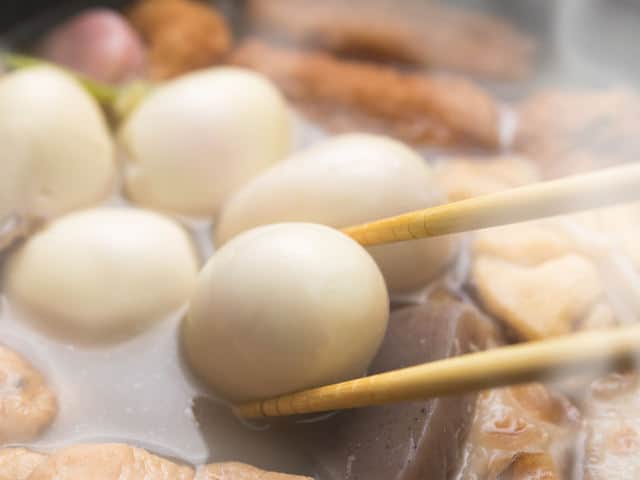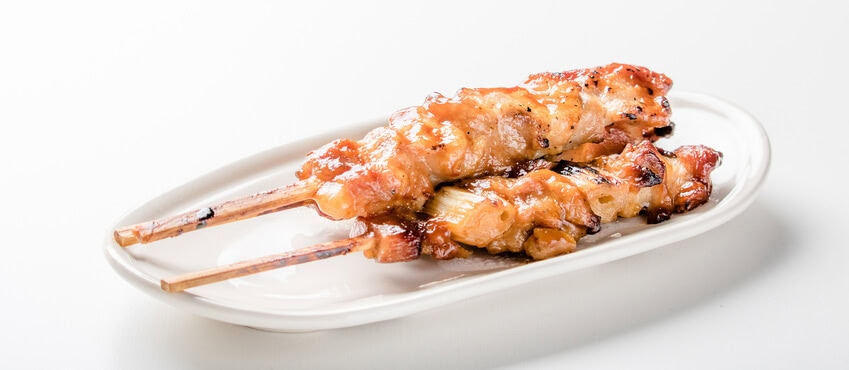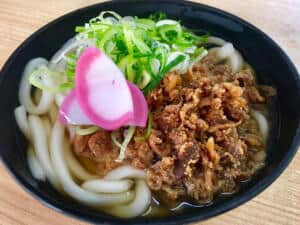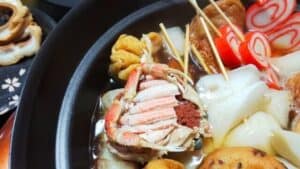When it comes to Japanese comfort food, Kagoshima Oden truly steals the show. Hailing from the charming southern island of Kyushu, this dish has a special place in the hearts and taste buds of both locals and those lucky enough to stumble upon it during their travels. Although there are different kinds of Japanese oden, the warmth and flavor of this local Kagoshima dish offers are truly special.
What is Kagoshima Oden?
Kagoshima Oden, often called Kagoshima-style miso oden, gets its special flavor from a hearty dose of miso. The ingredients then gently simmer in this savory mixture. It’s a uniquely delicious dish that’s sure to please your palate.
To make the soup base, combine chicken or pork bones with kelp and dried sardines. Then, season it with Kagoshima’s special sweet barley miso, along with grainy sugar and shochu. After that, add the ingredients and let them simmer. Important ingredients like pork bones, bean sprouts, and the unique oval-shaped tsukeage, a local-style Satsuma-age, complete the dish. This style is the same as Nagoya’s stew-like miso oden, possibly drawing inspiration from the renowned tonkotsu dish.
The broth boasts an enticing amber hue, crafted from white miso. Also, the toppings showcase the finest Kagoshima ingredients.
While not widely popular locally, Kagoshima Oden holds a special place in the hearts of those who frequent spots like the Observatory. This might also explain why it isn’t immediately recognized as a local specialty. It stirs a sense of nostalgia among Kagoshima Prefecture residents. A cherished tradition from late autumn through winter, some establishments serve it year-round, vouching for its popularity. Nevertheless, it’s not common in household kitchens. Even within Kagoshima Prefecture, you’ll only find a handful of places, outside of Kagoshima City, offering miso oden, like in Kirishima City.

Unfolding the History
The roots of Kagoshima Oden stretch back to the Edo period (1603-1868), where it started as a simple street food in Kagoshima Prefecture. Initially, it was just daikon simmered in a flavorful broth. But as time passed, it evolved, welcoming ingredients like konnyaku (devil’s tongue jelly), chikuwa (fish cake), boiled eggs, and more into its delightful mix.
Tenmonkan
Tenmonkan, which includes Kagoshima City’s central downtown and entertainment district, is a bustling center for both business and leisure.
Over the years, Tenmonkan has played a crucial role as a local shopping and entertainment hub. However, with the introduction of the Kyushu Shinkansen, new downtown areas and large commercial complexes have emerged around Kagoshima Chuo Station and the south-central part of the city. This shift has led to a noticeable decline in the area surrounding the astronomical museum in recent times.
Nevertheless, the famous oden restaurant in Tenmonkan still stands today. It’s still one of the favorites among locals despite the noticeably higher price of the menu in comparison with other shops.

FAQs
- Can I customize the Ingredients?
-
Certainly! You have the freedom to select ingredients that align perfectly with your palate, whether it’s fish cakes or tofu that tickle your taste buds.
- Is Kagoshima Oden healthy?
-
Yes. This dish not only offers a relatively modest calorie count but also packs a nutritional punch. Take daikon, for instance, which is a commendable source of dietary fiber and vitamin C. Moreover, the dashi-based broth subtly delivers a valuable dose of nutrients.
- What makes it unique?
-
When it comes to oden in Kagoshima, it’s the unique broth that truly sets it apart. This broth comes to life through a blend of dashi, soy sauce, mirin, sake, and sugar. Thus, the result is a rich, umami-packed foundation that truly brings out the flavors of all the ingredients.
Kagoshima Oden Recipe
Get ready to cook one of Kyushu Island’s comfort dishes. It’s not only unique, but it’s also rich in flavors and aroma.
Ingredients of Kagoshima Oden
| Good for 4 persons | |
| Pork spareribs | 250 g |
| Japanese white radish | 600 g |
| fried tofu | 1 sheet |
| carrot | 1 pc |
| egg | 4 pcs |
| black konnyaku | 1 sheet |
| soybean sprouts | 1 bag |
| tsukeage | 6 pcs |
| whole grilled chikuwa | 1 pc |
| satsuma age | 4 pcs |

On the other hand, below are the ingredients for the unique and savory dashi or broth.
| sweet barley miso | 130 g |
| water | 1600 ml |
| kelp | 10 g |
| sake | 2 tbsp |
| cane sugar | 1 1/3 tbsp |
| kneaded rice cake | appropriate amount |
How to make Kagoshima Oden?
To begin with, blanch the pork spareribs in boiling water to remove excess fat. Then, in a pot, combine water, kelp, and spare ribs. Heat them over medium heat. Just before it reaches a boil, remove the kelp and let it simmer over low heat for 15 minutes, while skimming off any scum.
Meanwhile, prepare the vegetables. Slice the radish into 3cm thick rounds, thinly peel them, and make a cross-shaped incision on one side. Boil them for about 30 minutes until a bamboo skewer easily passes through. Peel the carrots, slice them into half lengthwise, and then halve them again. Semi-boil them with the radish, and remove them when they become tender.
Then, boil the eggs in water for 8 minutes. Drain the water, and once cooled, peel them.

For the konjac, slice it into four triangles. Also, reduce the thickness by half and simmer in boiling water for 2 minutes. Cut the tofu into four triangular pieces. Then, put them on a colander with the satsuma-age and tenten sticks. After that, pour boiling water over them to remove excess oil. Cut the chikuwa in half and then slice them into two pieces again.
Strain the miso. Once done, add the remaining seasonings, daikon radish, and konjac. Heat them over medium heat. When it starts boiling, cover it and let it boil over low heat for 30 minutes.
Then, add tofu-age, and satsuma-age. Meanwhile, toss in the chikuwa, sliced carrots, and boiled eggs. Let it all simmer for an additional 10 minutes. Of course, season it with salt according to your preference.
Finally, remove from heat. On the other hand, combine the soybean sprouts and simmer them in broth before serving.
Where to buy?
Begin your Kagoshima Oden Japan adventure at its birthplace, Kagoshima City. Here, you’ll uncover traditional eateries and izakayas with rich histories.
Oden no Tsukasa (おでんの掌)

Step into Kirishima City and you’ll find a famous restaurant, welcoming its regulars at 5 pm sharp. The buzz starts at the counter, with patrons streaming in from the back. In fact, this izakaya is popular among workers in the area. This spot also draws in a lively crowd.
Meanwhile, the miso oden soup is carefully made by portioning out the soup stock using a sundou. In keeping with Kyushu tradition, it combines chicken stock with kelp. Hence, local ingredients are thoughtfully selected. Popular choices include bean sprouts, fish cakes, and large beef tendons, all commonly found in southern Kyushu. Another favored option is the separate preparation of “tonkotsu” alongside the oden hotpot.
Bunke Mujaki (分家無邪気)

Because of its proximity to Tenmonkan dōri Station, Bunje Mujaki is easy to locate. They offer one of the best oden in Kagoshima for reasonable prices. Aside from that, they also sell other delicious dishes such as yakitori and sashimi. In addition to the delectable dishes on the menu, the store also boasts a cozy vibe.
Tenmonkan Wakana Go Aijin Main Store (天文館吾愛人 本店)

Miso Oden is the specialty of this famous restaurant. As a matter of fact, the traditional taste has been passed down from generation to generation. The restaurant uses ingredients from local producers only such as radishes, eggs, konnyaku, etc.
Since Tenmonkan Wakana is a renowned store, the prices can be quite expensive. However, it is notable that the serving portion is so huge that it can feed up to two persons. Also, there are always long queues, especially during the weekend.
Meanwhile, it’s notable that many visitors of the renowned Tenmonkan Astronomical Museum also stop by the Go Aijin Main Store.
Takeaway
Whether you’re strolling the streets of Kagoshima City or exploring the culinary wonders of the area, finding authentic Kagoshima Oden is an adventure that promises to delight your taste buds. While there are many different kinds of model available in Japan, it’s still best to try as many as you can! Not only do they taste good, but they also carry a long history of tradition.
If you love Kagoshima Oden, you’ll surely love all these other varieties of oden. Aside from being delicious, it’s also nutritious. Perfect for those who want to find comfort in food while being conscious of nutrition. For example, Shizuoka Oden is a traditional winter cuisine from Shizuoka. It’s in fact a dish that the locals love to pair with alcoholic beverages in izakayas. Another one is Himeji Oden which is a local gourmet from Hyogo Prefecture. During the early period, it did not get much attention. Eventually, it has become a popular local food of Himeji City.
After a savory bowl of Kagoshima Oden, finish off your culinary adventure with the simple yet satisfying Japanese confectionery called Karukan.
















Comments